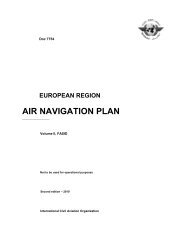7754 Vol 1 Flyleaf - ICAO Public Maps
7754 Vol 1 Flyleaf - ICAO Public Maps
7754 Vol 1 Flyleaf - ICAO Public Maps
Create successful ePaper yourself
Turn your PDF publications into a flip-book with our unique Google optimized e-Paper software.
IV-10 EUR BASIC ANP<br />
95. States should cooperate on a multinational basis to<br />
implement PBN in order to facilitate seamless and<br />
inter-operable systems and undertake coordinated R&D<br />
programs on PBN implementation and operation.<br />
96. States are encouraged to consider catering for traffic<br />
according to navigation capability and granting benefits to<br />
aircraft with better navigation performance, taking due<br />
consideration of the needs of State/Military aircraft.<br />
97. States should encourage operators and other airspace<br />
users to equip with PBN-capable avionics. This can be<br />
achieved through early introductions of RNP approaches,<br />
preferably those with vertical guidance.<br />
Safety Documentation & Monitoring Requirements<br />
Need for safety documentation<br />
98. To ensure that the introduction of PBN applications are<br />
undertaken in a safe manner, in accordance with relevant<br />
<strong>ICAO</strong> provisions, implementation shall only take place<br />
following conduct of a safety documentation that would<br />
demonstrate that an acceptable level of safety will be met.<br />
Additionally, ongoing periodic safety reviews should be<br />
undertaken where required in order to establish that<br />
operations continue to meet the target levels of safety.<br />
Use of specific navigation aids<br />
99. Where, within a given airspace, specific groups of users<br />
have been authorized by the competent authorities to use<br />
special aids for navigation, the respective ground facilities<br />
should be located and aligned so as to provide for full<br />
compatibility of navigational guidance with that derived<br />
from the internationally agreed and <strong>ICAO</strong> Annex 10<br />
compliant systems.<br />
100. States should ensure and oversee that Navigation<br />
Service Providers (i.e. providers of the navigation signals in<br />
space) take appropriate corrective measures promptly<br />
whenever a significant degradation in the accuracy of<br />
navigation aids (either space based or ground based or both)<br />
is detected.<br />
SURVEILLANCE<br />
Planning Considerations<br />
101. The <strong>ICAO</strong> European Region is currently characterized<br />
by the use of the following surveillance systems:<br />
a) Secondary Surveillance Radars (SSR)<br />
Mode A, C and S in terminal and en-route<br />
continental airspace;<br />
b) Primary Surveillance Radars (PSR)<br />
primarily in terminal airspace;<br />
c) Automatic Dependent Surveillance –<br />
Broadcast (ADS-B) and Wide Area<br />
Multilateration (WAM) in some parts.<br />
Automatic Dependent Surveillance –<br />
Contract (ADS-C) in some parts of the<br />
oceanic and remote continental airspace.<br />
102. In order to meet the anticipated future operational<br />
requirements by 2020 in an evolutionary manner, the<br />
following guiding principles to the development of<br />
surveillance infrastructure were agreed in the EUR Region:<br />
a) An independent surveillance system to<br />
track non-cooperative targets where and<br />
when required. This will be provided by<br />
PSR unless and until an alternative<br />
solution is required and developed;<br />
b) An independent surveillance system to<br />
track co-operative targets. This can be<br />
enabled by SSR Mode A/C or SSR Mode<br />
S or Wide Area Multilateration;<br />
c) Dependant co-operative surveillance<br />
based upon ADS-B providing positional<br />
data of suitable quality. The common,<br />
internationally agreed technical enabler for<br />
this type of surveillance is 1090 MHz<br />
Extended Squitter based ADS-B data link.<br />
ADS-C in remote and oceanic areas only;<br />
d) Since aircraft will have the necessary<br />
Mode S and ADS-B equipage, the choice<br />
of Cooperative surveillance technology<br />
(Mode S, ADS-B, Multilateration)<br />
remains flexible with the service provider<br />
determining the best solution for their<br />
particular operating environment, based on<br />
cost and performance;<br />
e) An increasing use of ADS-B and/or<br />
Airport Multilateration at aerodromes is<br />
also foreseen and, particularly, the use of<br />
the Advanced Surface Movement<br />
Guidance and Control System<br />
(A-SMGCS). Surface Movement Radars<br />
will provide the Independent<br />
Non-Cooperative airport surveillance; and














